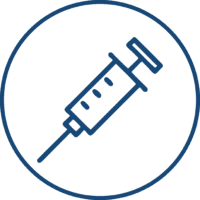Enrofloxacin 200mg /ml (ENROSTRONG20%)
Enrofloxacin
Pharmacology and Mechanism of Action
Fluoroquinolone antibacterial drug. Enrofloxacin is bactericidal with a broad spectrum of activity. In most animal species, enrofloxacin is metabolized to ciprofloxacin.
Indications and Clinical Uses
Treatment has included infections of skin and soft tissue, UTIs in dogs and cats, Chlamydophila felis infections in cats, and and ulcerrative colitis caused by Escherichia coli in dogs. It is also approved for treatment of bovine respiratory disease (BRD) associated with Mannheimia haemolytica, P. multocida, and Haemophilus somni (previously Haemophilus somnus).
Adverse Reactions and Side Effects
Avoid use in young dogs because of risk of cartilage injury. Do not administer to young foals; injury to articular cartilage has been reported. Use cautiously in animals that may be prone to seizures, such as epileptics. Do not administer to cats at doses greater than 5 mg/kg/day.
Do not mix in solutions or in vials with aluminum, calcium, iron, or zinc because chelation may occur. Enrofloxacin may precipitate in an IV line if injected directly into IV fluids.
Small Animal Dosage
Dogs
• 5-20 mg/kg/day IM, PO, or IV.
Cats
• 5 mg/kg/day PO or IM. (Avoid intravenous use in cats.)
Exotic Animals
• Usually 5 mg/kg/day or in reptiles, every other day.
Birds
• 15 mg/kg q12h IM or PO.
Large Animal Dosage
Cattle (BRD)
• Single dose: 7.5-12.5 mg/kg once SQ (3.4 to 5.7 mL per 100 pounds).
• Multiple-dose:: 2.5 to 5 mg/kg SQ (1.1 to 2.3 mL per 100 pounds) once daily
for 3 to 5 days.
Swine (SRD)
• 7.5 mg/kg SQ, behind the ear.
Dosage
2.5-5 mg/kg/day by I.M. orS.C. route
Enrofloxacin 100mg /ml (ENROSTRONG10%)


